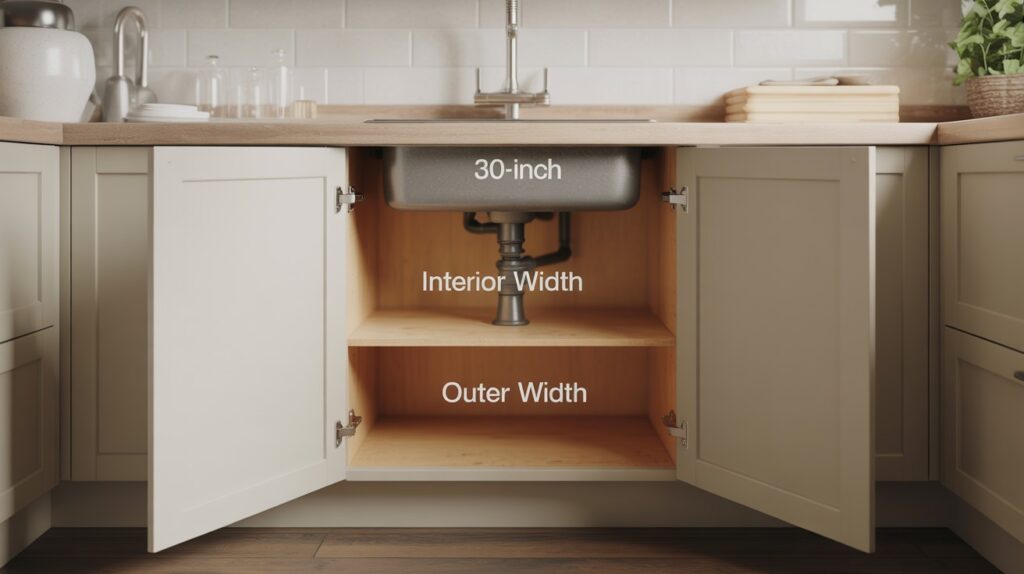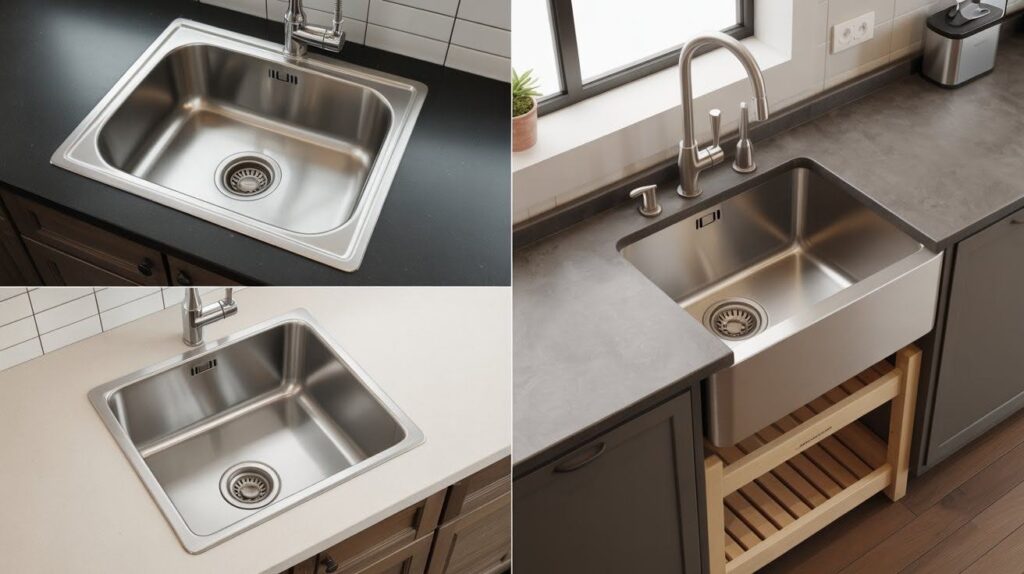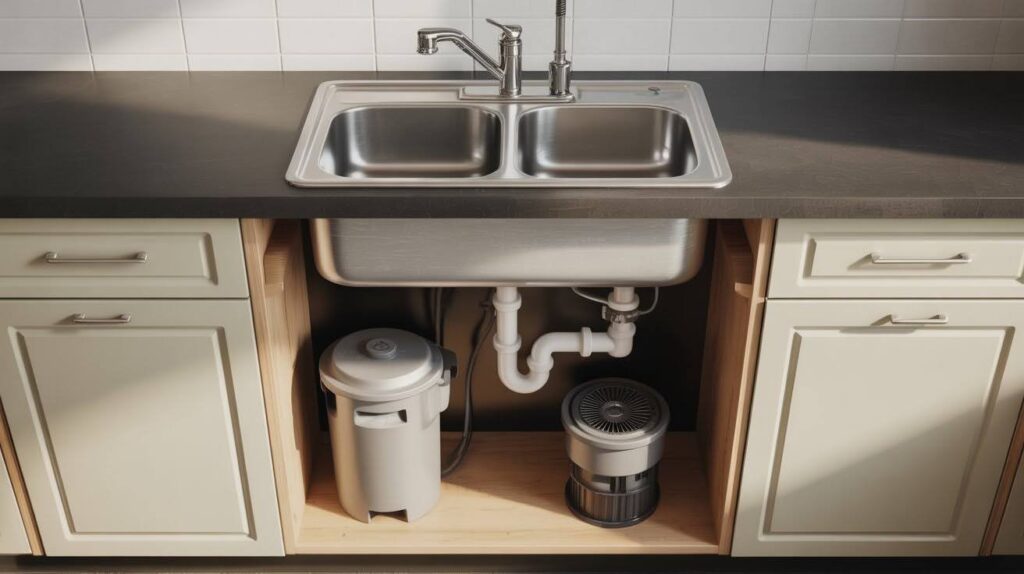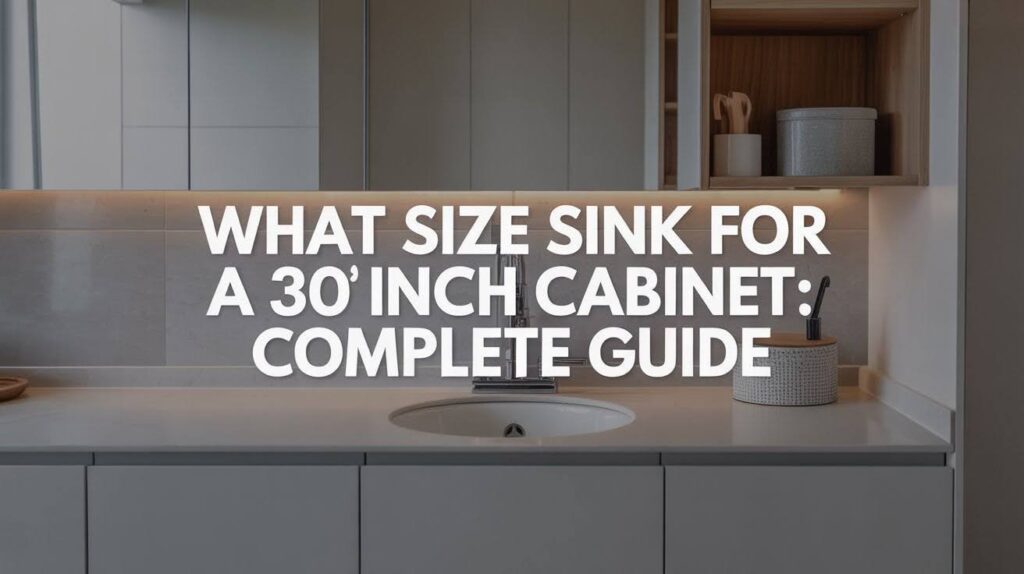Choosing the correct sink size for a 30 inch cabinet can be complicated.
I have guided dozens of homeowners to the solution of this same scenario, and have heard the frustration of several people stating that the measurements aren’t working.
In this guide, you will learn: the precise dimensions of the sinks that fit, the reason the full 30 inch sink won’t work, and advice for installation tips for sinks.
I will detail the 26 to 28 inch range that fits best and how to take measurements.
This guide will provide simple answers with edits from my real world experience as a sink installer. No guessing.
By the end of the guide, you will have a clear indication of which sink you need to buy.
What Size Sink for a 30 Inch Cabinet?

The right sink for a 30-inch cabinet is 27 inches wide. You can safely use sinks between 26 and 28 inches, but 27 inches offers the best fit. A full 30-inch sink won’t work because your cabinet’s interior width is smaller than the outside measurement.
Cabinet walls and mounting hardware need space too. This leaves you with about 28.5 inches of usable interior width. Choosing the correct size prevents installation problems and ensures your sink sits securely.
The 27-inch size gives you a functional bowl while leaving proper clearance for clips, brackets, and support structures underneath.
Understanding Sink Size for a 30-Inch Cabinet

Learn how cabinet dimensions affect sink selection and why interior space matters more than outer measurements.
Why Cabinet Size Matters
Your cabinet size controls which sink will fit. A 30-inch cabinet seems straightforward, but the usable space inside is smaller. Most people measure the outside width, which leads to buying sinks that don’t fit.
Outer Cabinet Width vs. Interior Width
The outside measures 30 inches, but cabinet walls take up space. Side panels are usually 3/4 inch thick on each side. This means your interior width is about 28.5 inches. Always measure the inside space.
How Sink Dimensions Are Determined
Sink manufacturers list the overall width, including the rim. You need clearance for mounting clips underneath. Standard clearance is 1 to 1.5 inches on each side.
Will a 30-Inch Sink Fit in a 30-Inch Cabinet?

Find out why matching sink and cabinet widths don’t work and what clearance you actually need.
Interior Width Limitations:
A 30-inch sink cannot fit in a 30-inch cabinet. Your cabinet interior is already less than 30 inches, and the sink needs side clearance too.
Why a Full 30″ Sink Usually Doesn’t Fit:
Cabinet walls reduce interior space to about 28.5 inches. Clips and brackets require space to grip the underside. The rim also needs solid countertop support.
Mounting Hardware & Clearance Needs:
Drop-in sinks need rim support all around. Undermount sinks require clips on the sides. Always allow 1 to 1.5 inches of clearance on each side for safe installation.
What Size Sink Fits in a 30-Inch Cabinet?

Get the exact measurements that work best and learn why 27 inches is the ideal choice.
Ideal Sink Width Range: 26″-28″:
The best sink size is 26 to 28 inches wide. A 26-inch sink gives extra room for mounting hardware. A 28-inch sink maximizes bowl space while still fitting safely.
Best Choice: 27-Inch Sink:
I recommend a 27-inch sink for most 30-inch cabinets. You get a good-sized bowl with enough clearance for clips. Most manufacturers offer 27-inch models at reasonable prices.
Recommended Bowl Depth:
Bowl depth affects functionality and plumbing clearance. Standard depth is 8 to 10 inches. I prefer 9-inch depth for most kitchens.
Sink Size Recommendations by Installation Type

Learn specific measurements for drop-in, undermount, and farmhouse sinks in 30-inch cabinets.
Drop-In Sinks: Drop-in sinks sit on top of the countertop. A 27-inch size is ideal for a 30-inch cabinet. Single bowl works best. The rim hides cut edges and installation is DIY-friendly.
Undermount Sinks: Undermount sinks attach underneath the counter. Stick to 26 to 27 inches since these need more side clearance. Mounting clips require 1 to 1.5 inches of space on each side.
Farmhouse / Apron-Front Sinks: Farmhouse sinks have an exposed front panel. A 27-inch farmhouse sink works but requires modifications. You’ll need to cut the cabinet face frame and add extra support. These sinks are heavy and need reinforcement.
Can a 29-Inch Sink Fit in a 30-Inch Cabinet?

Learn professional methods for tight installations and when pushing limits makes sense.
Standard Recommendations (Why It Shouldn’t Fit):
Standard guidelines say no. A 29-inch sink leaves only 0.25 inches per side. This margin is too tight for most installations and risky for DIY installers.
Advanced Installation Methods Used by Professionals:
Professional installers sometimes make 29-inch sinks work using precise centering, trimming cabinet walls slightly, or using custom wood blocking instead of standard clips.
Risks & Limitations of Tight Installations:
Tight fits increase installation time and cost. You might crack the sink during installation. I only recommend this for experienced installers.
How to Measure Your Cabinet Correctly

Follow these steps to get accurate measurements before buying your sink.
Open your cabinet doors and measure the inside from wall to wall. Use a tape measure and get the narrowest point. This is your maximum sink width before accounting for clearance.
Look at how far your countertop extends over the cabinet opening. The sink rim must sit on solid counter material.
The flange is the outer rim that sits on your countertop. Most flanges are 1 to 2 inches wide. This affects the actual bowl size.
Check where your faucet will mount and if you need holes for soap dispensers or sprayers. Make sure there’s wall clearance if your sink sits against a backsplash.
Depth & Plumbing Considerations

Understand how bowl depth affects functionality and plumbing installation under your sink.
Ideal Bowl Depth for Functionality:
An 8 to 10-inch deep bowl works well for most kitchens. I find 9 inches to be the sweet spot for comfort and functionality.
Garbage Disposal & P-Trap Clearance:
Garbage disposals add 12 to 18 inches below the sink drain. Make sure your cabinet is tall enough. You need at least 18 inches from the sink bottom to the cabinet floor.
Impact on Usability in Smaller Kitchens:
Very deep sinks feel awkward in small kitchens. Consider your height and comfort when choosing bowl depth.
Bathroom Note: What Size Sink for a 30-Inch Vanity?

Bathroom vanities have different requirements than kitchen cabinets due to faucet and counter space needs.
Recommended Sink Width (Up to 22″):
Bathroom sinks are typically smaller. For a 30-inch vanity, stay under 22 inches wide to leave counter space for toiletries.
Maximum Sink Length (Up to 28″):
Sink length (front to back) can be up to 28 inches. Standard vanity depth is 21 inches.
Best Sink Styles for Bathroom Vanities:
Undermount rectangular sinks work beautifully. Vessel sinks sit on top and save space. Drop-in oval sinks are classic and affordable.
Balancing Counter Space & Aesthetics:
Leave 3 to 4 inches on each side. This counter space is practical and makes the vanity look balanced.
Sink Size Guide for Other Cabinet Widths

Quick reference for common cabinet sizes and their ideal sink dimensions.
Sink Size for 27-Inch Cabinet: A 27-inch cabinet fits a 24-inch sink comfortably. This size works for compact kitchens.
Sink Size for 33-Inch Cabinet: A 33-inch cabinet accommodates a 30-inch sink. Double bowl sinks work well at this width.
Sink Size for 36-Inch Cabinet: A 36-inch cabinet fits a 33-inch sink easily. This size is ideal for busy kitchens with large pots and pans.
Installation Tips & Best Practices
Follow these professional tips to ensure a successful sink installation in your 30-inch cabinet.
- Always Measure Interior Width First: Never assume standard dimensions. Measure before shopping for a sink and double-check your numbers.
- Reinforce Cabinets for Heavy Sinks: Cast iron and fireclay sinks are heavy. Add plywood to the cabinet bottom for extra support.
- Importance of Professional Installation for Tight Fits: Hire a professional for expensive sinks or tight installations. The installation cost is worth avoiding damage.
- Ensuring Even Support for Undermount & Farmhouse Sinks: Check that clips or brackets are evenly spaced. Use enough mounting points and test the sink before finalizing.
Conclusion
Choosing what size sink for a 30 inch cabinet doesn’t have to stress you out. A 27-inch sink is your best bet, giving you the right balance of bowl space and safe installation.
I went through this exact decision three years ago in my kitchen remodel. That 27-inch undermount I picked? Still works great, and installation was straightforward. Trust me, measuring twice and buying once saves so much hassle.
Got questions about your specific cabinet? Drop a comment below. I’d love to hear what you end up choosing!
Frequently Asked Questions
Can I install a 28-inch sink in a 30-inch cabinet?
Yes, a 28-inch sink can fit in a 30-inch cabinet if your interior width is at least 28.5 inches. You’ll have minimal side clearance, so professional installation is recommended to ensure proper support and mounting.
What’s the difference between sink width and bowl width?
Sink width includes the rim or flange that sits on the countertop. Bowl width is the interior space where you wash dishes. The rim typically adds 1 to 2 inches to the overall sink dimensions.
Do I need to modify my 30-inch cabinet for a farmhouse sink?
Yes, farmhouse sinks require cabinet face frame modifications since the sink front is exposed. You’ll need to cut away the front panel and reinforce the cabinet base to support the extra weight.
How much clearance do undermount sink clips need?
Undermount sink mounting clips require 1 to 1.5 inches of clearance on each side. This space allows the clips to attach securely to the cabinet sides or support blocking underneath the countertop.
Can I use a double bowl sink in a 30-inch cabinet?
Double bowl sinks in a 27 or 28-inch size will have very small basins. A single bowl provides more usable space. If you want double bowls, consider upgrading to a 33 or 36-inch cabinet.

